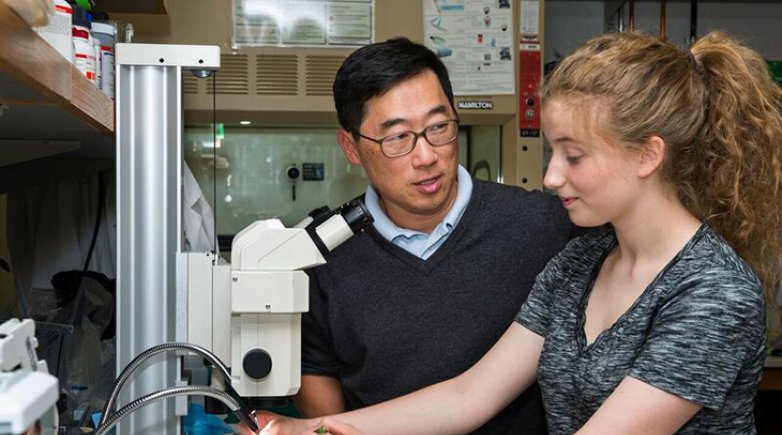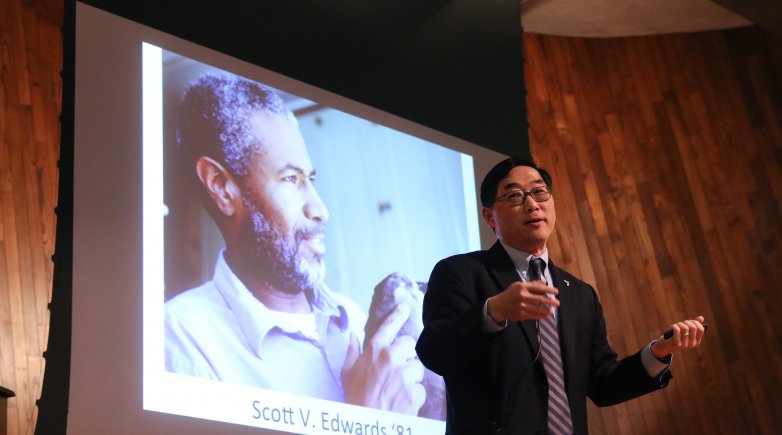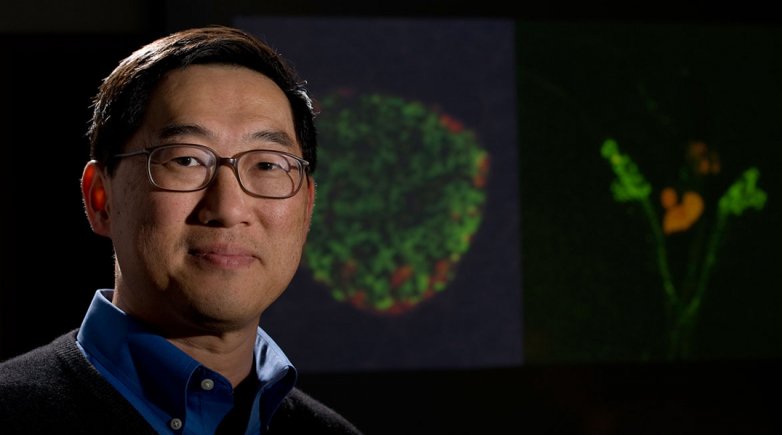Farming Fruit Flies for Science
Exonians practice experimental science in one alum's research laboratory at Stanford.
When Emma Herold ’13 arrived at Stanford this past summer to work in a research laboratory, the senior scientist who served as her mentor told her, “For the first month, you’ll feel like you’re drinking from a fire hose.” This turned out to be an apt metaphor, Herold says, for an experience with a steep learning curve. Each day she encountered something new, from mastering basic lab techniques to understanding the genetics behind the experiments she conducted. But Herold wouldn’t trade her long days in the lab for a summer of scooping ice cream or lifeguarding.
Herold began most mornings on one of her primary tasks, breeding fruit flies. This involved a session of “flipping” her flies by placing live fruit flies into tiny vials and tracking any eggs laid. The painstaking work requires a disciplined attention to detail and careful record keeping—skills Herold enjoyed perfecting. The knowledge that her contributions might eventually play a part in the discovery of treatments for diabetes and pancreatic cancer made every piece of the process vitally important.
“The sheer amount of information I took in was amazing,” Herold says about the internship. “I learned so much. Now I know what lab scientists do. I have a real-world understanding of different types of work and how people live their lives.”
Herold’s firsthand experience in lab research was made possible through the generosity and vision of Dr. Seung Kim ’81, who brought three Exeter students to work in his lab this past summer. A member of the Stanford faculty in the Department of Developmental Biology and Medicine (Oncology Division), and an investigator for the Howard Hughes Medical Institute, Kim is conducting research on how pancreatic islet cells develop, function, regenerate and change in disease.
Kim’s lab has demonstrated that drosophila, or fruit flies, have endocrine cells that work in a similar fashion to human islet cells, producing insulin as human cells do. Prior to Kim’s discoveries, scientists were uncertain whether fruit flies had the equivalent of a pancreas. Now he is using strains of drosophila to uncover the molecular and cellular instructions for making islet cells. His investigations could play a significant role in advancing the disciplines of stem cell and regenerative biology, and lead to a means of replicating and inserting healthy islet cells in patients with diabetes whose cells no longer produce insulin. In helping scientists understand the function of the pancreas better, his research could also provide insights into pancreatic cancer.
The summer internships Kim arranged this year were just the beginning of exciting new opportunities for Exeter students. At Kim’s suggestion, the Academy is embarking on a unique collaboration between his lab and the Science Department. The fruit flies Herold helped breed will be shipped to Exeter this spring for further study in Biology 374, a new course that will give students a direct role in the work of Kim’s lab and experience in genetics research. Interest among students eligible to apply for the 12 spaces in two sections of Biology 374 has been high.
Science Instructor Townley Chisholm P’10, P’11, P’14, who will teach one section of Biology 374, says of the new undertaking, “The course has the potential to be a tour-de-force demonstration of the power of modern genetics research in a high school setting, and the collaboration with Kim’s lab gives our students the chance to talk directly with people who know this field from A to Z. My Advanced Biology students absolutely loved talking by teleconference and video link with Dr. Kim and his colleague Dr. Lutz Kockel this past May because the Stanford researchers were incredibly knowledgeable, as well as being tremendously encouraging, warm and funny in handling our questions.”
In recent decades, Exeter has seen a high percentage of students enroll in advanced courses in science, math and technology, with many pursuing careers in these fields. Nationally, however, the United States is facing a decline in workers trained for STEM (science, technology, engineering and math) careers. In the 1970s, about 40 percent of the world’s scientists and engineers resided in the U.S.; today that number stands at about 15 percent. The U.S. Department of Labor estimates that while only 5 percent of U.S. workers are employed in fields related to science and engineering, they are responsible for more than 50 percent of our sustained economic expansion. The need to encourage young people to go into STEM fields is clear.
President Barack Obama has introduced the Educate to Innovate effort to support the goal of increasing both interest in STEM fields and mastery of these subjects. It is no secret that American students rank far below their peers in developed countries in science and math literacy. A 2006 study placed Americans 21st out of 30 developed countries in science literacy and 25th out of 30 in math literacy. The Educate to Innovate program is enlisting leading companies, foundations, nonprofits, and science and engineering societies to partner with the government in promoting science and math education.
Exeter’s approach to teaching science and math, firmly rooted in the Harkness tradition, places the engagement and initiative of students at the center. Classes focused on discussion and experimentation put the tools of discovery in students’ hands. But the collaboration with Kim’s lab takes Harkness learning to a new level by giving students a part to play in his research. This is exactly the sort of education President Obama’s initiative is designed to encourage.
“Science is not about teaching already-known facts but discovering new ones,” Kim says. “We would love it if students came away from this experience interested in pursuing science, but the goal is not necessarily to train people to be scientists. My hope is to expose students to what science is about, and that is discovery.”
Anika Ayyar ’14, one of the students who interned in Kim’s lab, will serve as a teaching assistant for Biology 374 along with Herold. They are now experts in the technical aspects of breeding fruit flies and conducting experiments on them, and in the science behind Kim’s research. The prospect of sharing their knowledge with fellow students and seeing the experiments through to the next stage is empowering. “I have always been interested in the complexity of cells and how they work and control everything in the body,” Ayyar says. “It’s surprising how much you can manipulate the fruit flies and how much can be learned. A lot of what we are discovering can be applied to humans.”
Ayyar can take special pride in her role in the new course because without her initiative, it would not have happened. While enrolled in a summer science program at Stanford in 2011,Ayyar learned that Kim was on campus and stopped by to introduce herself to a fellow Exonian. Ayyar was so impressed with Kim and the tour he gave her of his lab that she returned to campus and suggested Exeter invite him to speak in assembly. His assembly talk in February 2012 and a special session with the Biology Club generated a lot of discussion among students and faculty about the role of the scientist in the world.
One outcome of these conversations, a suggestion made by Kim and eagerly embraced by Principal Tom Hassan and the Science Department, was the proposal for a collaborative research project. Kim returned to Stanford and asked his research team to come up with a protocol students could execute in an 11-week course. When the complexity of pulling this off became clear, he proposed bringing Exeter students to Stanford for training in the summer so they could, in turn, train their peers back on campus.
Last spring, Chisholm’s Advanced Biology course conducted some preliminary experiments with drosophila sent through the mail from Kim’s lab. This test run was a success, proving that the flies could travel cross-country, with the help of the U.S. Postal Service, in vials that provide access to oxygen and food. This spring, Kim’s lab will ship the strains of drosophila that Herold and Ayyar helped to create with Kim’s colleague, Dr. Sangbin Park, during their internships.
“Drosophila have about 15,000 genes,” Kim explains. “Humans have 30,000. Flies turn out to be extraordinarily good organisms for the study of gene and cell function. If you destroy just 12 cells in the fly brain, you get a diabetic fly.”
In the strains of drosophila bred by Herold and Ayyar over the summer, modified genes have been inserted into the flies along with a regulator that allows the researcher to turn gene expression on or off in a particular cell or type of cell. The regulator binds to the modified gene and glows green under the microscope so researchers can see how the modified genes manifest in succeeding generations of flies. Students in Biology 374 will conduct a series of experiments that involve breeding the flies and charting the path and functioning of the modified genes. The result, it is hoped, will be a new research-ready strain of drosophila that can be used by scientists working on research in a wide range of areas.
“The students will learn to do fly husbandry,” Kim says. “In the second part of the course, they will use molecular genetics to see where in the genome the regulator shows up. If each team of students is able to identify several new insertions next to genes that mark cells, that would be a wonderful outcome. We don’t know that this will be the outcome, though. We want the students to have an experience of open-ended investigation.”
Science instructors at Exeter and Kim have made a long-term commitment to this project. Exeter students will have the opportunity to intern in the Stanford lab again next summer and to serve as teaching assistants for the next round of the course. Over time, Kim hopes that a named collection of fly strains will result from the collaboration and that the outcome of the experiments can be published. He sees Exeter students and faculty playing a role in any eventual publication and in possible presentations at conferences. If the project is successful, it could impact research on a variety of diseases and genetic conditions. Kim hopes to extend this sort of partnership to public schools in his area in the future, as well.
Trained as an oncologist, Kim was motivated to leave his practice and go into research by the suffering he saw among his patients. “I was struck by how horrible pancreatic cancer is among diseases and how little we know about it. I saw my patients dying from pancreatic cancer and diabetes. I decided to pursue this open area of research as a chance to make a contribution, taking a molecular and cellular biology approach to studying insulin cells.”
In addition to his research, Kim directs the M.D./ Ph.D. program at Stanford and is a recipient of the Henry J. Kaiser Family Foundation Award for Excellence in Preclinical Teaching. He completed an undergraduate degree in biochemistry at Harvard, and his Ph.D. in biochemistry and M.D. at Stanford. His background as both a doctor and researcher gives him a broad perspective unique in the research world.
It was only by chance that he began working with fruit flies, when another scientist suggested it during a job interview. Kim discovered what he calls a “marvelous system” for research and a 100-year history of investigation using drosophila. “It took some elbow grease to figure out how to measure glucose levels in a fruit fly, but it is possible,” he comments. “This is the wonderful thing about science. You can adapt and relearn in a relatively short period of time.”
Jack Russ ’13, the third student who interned in the Stanford lab over the summer, says that it was an eye-opening experience. “I imagined science the way I had seen it in the movies, with bubbling cauldrons and high-tech machinery,” he says. “The reality is more everyday. You have rows of shelves lining the lab and things are on a smaller scale, working with small equipment. A lot of little discoveries may add up to something big.”
Russ worked on mammalian cells in a different area of Kim’s research, unrelated to the preparation for the collaboration with Exeter, but like Herold and Ayyar, he gained valuable insight into what a career as a research scientist demands. Among other things, it requires a high tolerance for failure, Russ says. “I have learned the value of failure. I spent all day working on a single experiment. I worked hard and did everything I was supposed to do, but the results did not add up at all. I said to Dr. Kim, ‘I failed at this experiment.’ He said, ‘Yes, that’s great. You failed.’ He made me understand that failure can be just as important as success.”
Russ enjoys solving problems and definitely wants to go into science—possibly engineering, perhaps biomedical engineering or mechanical engineering. Herold, who says she has always been a “science girl” and comes from a “geek family,” sees herself as following a career path in science of some sort. Ayyar would like to become a neurosurgeon or neuroscientist. All three students feel they now have a much greater appreciation for the importance of research and the persistence it demands. “I’ve learned to be a lot more meticulous in my work in the lab and handling of the flies and equipment,” Ayyar says. “If one egg gets in the wrong vial, you have to throw everything away and start over.”
Among the surprise discoveries made by the students over the summer was how much fun working in a lab can be. Russ comments, “The lab is a people place. People are constantly collaborating and conferring with each other. I was always asking questions.” All three students worked one-on-one with a senior scientist in the lab and did extensive background reading. Ayyar and Herold were impressed, like Russ, by the collaborative nature of research in a laboratory setting and by the enthusiasm every member of the team brought to the work.
Science Instructor Anne Rankin ’92 will teach the other section of Biology 374 this spring. She notes that while research courses are becoming common in high schools, what Exeter is offering gives students access to high-level research and to the scientists conducting it: “I am excited about our version because it is providing tools which will be used by researchers in this field, and it fits into a much larger research context. Our students will read papers relevant to the work they are doing and have the chance to discuss them with Dr. Kim and others in his lab.”
Rankin and Chisholm traveled to California in May to spend time in Kim’s lab and learn more about his research. Chisholm returned in August to nail down the final details for the course. Both say that this opportunity has fired them up about what is possible in the classroom. “I am a dinosaur,” Chisholm says. “I graduated from college in 1979 and have never used genetic techniques of this kind. Working with Dr. Kim has been the best professional development I can imagine. I certainly will not be doing the same old boring drosophila crosses with my Advanced Biology classes anymore.”
Rankin agrees, commenting that having the chance to be the student rather than the teacher was wonderful. “I loved experiencing the open-endedness of science again, as that is something that can be hard to hold on to in a high school classroom.”
This is just the sort of experience Kim sought to promote when he proposed the joint research project, for faculty and students alike. “We also want to expose students to the habits of scientific thinking,” he says. “Science teaches adaptability, patience, communication, and evokes a range of emotions people don’t associate with science—anxiety about failure but also the addictive moments of real joy when you understand something about nature you did not before.”
Those moments of real joy have kept Kim in the lab and sustained the hope that his discoveries may contribute to a greater understanding, even a cure, for the diseases he witnessed firsthand as a doctor. Exeter students and teachers are poised to make a significant contribution to those discoveries.



